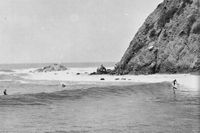It’s hard to imagine a time when Southern California’s coast was dotted with legendary, untouched surf breaks—waves that drew the best surfers from miles around and shaped the culture of entire communities. Yet, for decades, one spot reigned supreme in the hearts of wave riders: Killer Dana, a right-hand point break at Dana Point. Stretching out like a natural amphitheater, this iconic wave peeled for up to 500 yards, offering rides that rivaled Malibu for consistency and Rincon for sheer length. But what truly set Killer Dana apart was its punch. Swells from the open Pacific would travel up the coast, bend into perfect lines, and explode into powerful, glassy walls that challenged even the most seasoned surfers.
From the 1930s through the 1960s, Killer Dana wasn’t just a wave—it was the beating heart of a vibrant, tight-knit waterman community. Local legends like Lorrin "Whitey" Harrison, George "Peanuts" Larson, and Ron Drummond became household names in the surf world, carving their paths on this formidable point. The lore only grew when, in 1939, Peanuts Larson allegedly rode one of the largest waves ever attempted on the California coast. By the 1950s, a new generation was making its mark. Phil Edwards, only 13 at the time and destined to become a Pipeline pioneer, stunned onlookers in 1953 with his innovative “hotdog” style. As Greg Heller of Surfline recalled, "He dropped all jaws with his silky fades and radical redirections."
But Killer Dana was as dangerous as it was beautiful. The takeoff zone was lined with sharp rocks, and a kelp-covered boulder lurked at certain tides, creating a notorious boil that could snap boards and send surfers swimming for shore. In the words of the 1963 "Surfing Guide to Southern California," "Thick lines wind around the point and build up on outside reefs, with fast takeoff on larger swells (6 to 12-15 feet) developing into a slower, mushier, but often well-shaped lineup." On big days, the wave demanded respect—and sometimes extracted a heavy toll. As Miki Dora later quipped, "The only ones I've ever heard of being killed there were a couple of over-anxious Valley kooks who slipped on a banana peel." Still, the danger was real, and the wave’s reputation only grew.
Surfing at Killer Dana wasn’t just about the ride. Dana Point itself was a true surf town, where locals fished for lobster, speared abalone, and spent endless days in the cove. The area became an industry hub, with Hobie Alter opening his surfboard shop nearby and Surfer magazine founded just blocks away. Filmmaker Bruce Brown, years before "The Endless Summer," was a familiar face in the lineup, as were Corky Carroll, Bill Hamilton, and visiting Hawaiian chargers like Jock Sutherland. The cove was more than a surf spot—it was a lifestyle, a rhythm dictated by the tides and the ever-present Pacific.
Yet, like so many surf gems, Killer Dana’s fate was sealed by the march of progress. In the early 1960s, city leaders unveiled plans for a massive marina at Dana Point, promising economic growth in the form of boat slips, condos, shops, and a steady flow of tourists. Surfers saw it differently: the destruction of a natural wonder and the erasure of a culture. Ron Drummond, a local legend, even proposed an alternate harbor design to preserve the wave, but his pleas fell on deaf ears. Officials dismissed the surfers, reportedly saying, "We don't want those surfer vandals in our harbor."
The writing was on the wall. By 1965, the U.S. Congress had funded the harbor project. In 1966, thousands gathered to watch the first boulders tumble into the cove, marking the beginning of the end for Killer Dana. For the surfers on the beach, it felt like a funeral. On August 29, 1966, the wave was surfed for the last time, with Peanuts Larson and Ron Drummond among those taking a final ride. Soon after, the cove was closed to "marine activities," and bulldozers moved in. Within two years, Dana Point Harbor stood where Killer Dana’s perfect lines once rolled in.
The loss of Killer Dana was profound—not just for surfers, but for the entire California coast. The construction of the harbor didn’t just bury the wave; it erased a whole landscape. Princess Point, Fisherman's Reef, and other beloved breaks vanished under concrete and rubble. The famous headland itself was leveled, and with it, an irreplaceable chapter of surf history was lost. As Matt Warshaw later wrote in "The History of Surfing," "Surfing environmentalists long waved the bloody flag of Killer Dana, a beautiful headland-fronted Orange County point wave buried in 1967 beneath the new Dana Point Harbor."
Yet, the memory of Killer Dana endures. A time capsule, hidden inside the first harbor boulder in 1966, contained a photo of local surfers preparing for one of their last sessions. Their faces are grim—a testament to the weight of the moment. The capsule was set to be opened in 2016, fifty years after the wave’s demise, as a reminder of what was lost and a warning to future generations. Today, Dana Point Harbor is home to yachts, restaurants, and parking lots. Doheny, the nearby soft longboard wave, is all that remains for surfers. But for those who remember, or who have heard the stories passed down, Killer Dana is more than a lost break; it’s a symbol of the tension between progress and preservation, between community and development.
The legacy of Killer Dana lives on in the stories of those who rode its perfect rights, who braved its hazards, and who fought—however unsuccessfully—to save it from destruction. It became a rallying cry for the environmental movement within surfing, inspiring groups like the Surfrider Foundation to fight for the protection of remaining surf breaks. And as the years pass, the flag still flies for Killer Dana, a reminder of Southern California’s golden age and the importance of safeguarding the treasures that remain.
As the 2025 WSL Championship Tour wraps up another season of triumphs and heartbreaks in far-flung destinations like Teahupo’o and J-Bay, the story of Killer Dana serves as a poignant backdrop. Waves come and go, champions rise and fall, but the lessons of the past—about community, stewardship, and the fragility of our surf heritage—resonate louder than ever. For those who paddle out at Dana Point today, the ghost of Killer Dana lingers, a challenge to cherish what’s left and to fight for the waves that define us.




